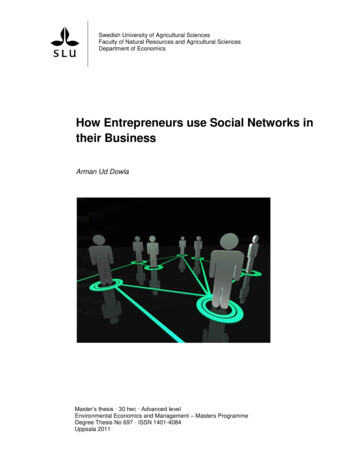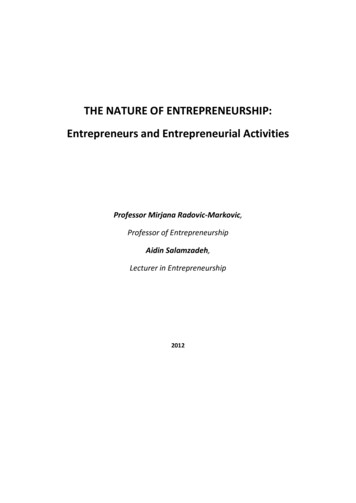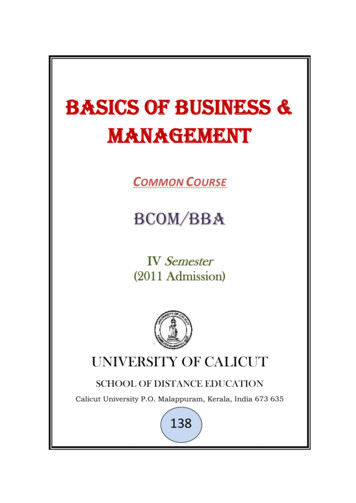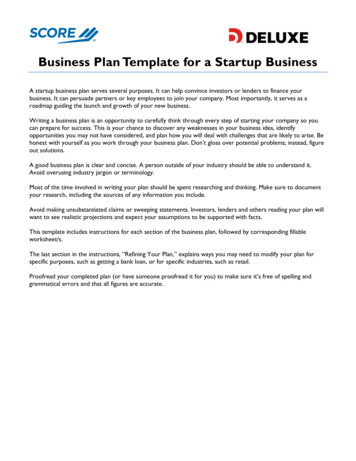
Transcription
Business Basics for EntrepreneursBy: Jarie BolanderAn eBook Based on The Daily MBA Serieshttp://www.thedailymba.com
Business Basics for EntrepreneursContents1 Introduction: Business Basics for Entrepreneurs42 Topic #1: What is Business Anyway?53 Topic #2: Business Structures74 Topic #3: Business Ethics105 Celebration Of Knowledge #1126 Topic #4: Marketing Basics157 Topic #5: Target Marketing188 Topic #6: Marketing Promotion Strategies219 Topic #7: The Basics of Economics2410 Celebration of Knowledge #22811 Topic #8: Accounting Basics3112 Topic #9: Financing3513 Topic #10: Financial Models3914 Celebration Of Knowledge #34215 Topic #11: The Sales Role4516 Topic #12: Business Development4817 Topic #13: Negotiating5018 Topic #14: Tactics, Strategy and Grand Strategy5319 Celebration Of Knowledge #45520 Topic #15: Research & Development5821 Topic #16: Intellectual Property6122 Topic #17: Product Launch / Management6523 Topic #18: Operations / Manufacturing6824 Celebration Of Knowledge #57125 Topic #19: Managing People7426 Topic #20: Doing Business Internationally782Copyright c 2011 Jarie Bolander
Business Basics for Entrepreneurs27 Topic #21: Organizational Structures8228 Topic #22: Legal Aspects of Running a Business8629 Celebration Of Knowledge #69030 Bonus Topic: Public Relations9331 Bonus Topic: Starting A Business9632 Bonus Topic: Business Startup ChecklistCopyright c 2011 Jarie Bolander1023
Business Basics for Entrepreneurs1Introduction: Business Basics for EntrepreneursFor me, learning is a series of small steps. Each one, a fragment of the whole. The whole the sum of thefragments. That’s the way Business Basics for Entrepreneurs will approach each topic – small, incrementalsteps leading toward a layered knowledge. Business Basics for Entrepreneurs is designed to be done in15-30 minute pieces. This allows the reader to learn the topics in manageable chunks. The key is to spend15-30 minutes a day engaged with the material.1.1The CoreEach section presents a different topic. The order of the topics is what I consider the logical order requiredto build your knowledge. This approach makes it much easier to grasp concepts that you may not befamiliar with. After every couple of topics, there is a Celebration Of Knowledge (COK), which reviews thepast few topics learning (I hate tests and quizzes. Celebrations are so much better) These are meant asguild posts on your journey – natural places to check in to see how you are progressing.1.2OrganizationThe topics are organized into sections with a total length between 500 and 1500 words (2-5 pages) – justenough to grasp the basics. Each topic has the following sections: Talking Points: The main points of the post. These will generally correspond to the main textheadings. Discussion: The core discussion of the post. The talking points from above will be broadened outand explored. Things To Ponder: Exercises that reinforce the material. Exploring Further: Books, web sites or articles that dig deeper into the subject.1.3Who is this for?A lot of people are scared of business but creative types are down right terrified of it. Creatives squanderopportunity after opportunity because they fear business. This fear stems from their overwhelming desireto just create and not deal with the ugliness of selling their creations. This series is geared toward thebudding entrepreneur that is either an artist, writer, scientists or engineer who struggle everyday to graspthe basics of business and sell what they create. One thing to remember is that business is not that hard– it’s just a different way of thinking. You don’t have to sell out or compromise to be successful. The trickis to understand what you want out of a venture and move towards those goals. The best way to do thatis to get the basics down before you jump in.1.4Time To StartNow that you have the outline of the series, it’s time to begin. Business Basics for Entrepreneurs goesthrough 22 topics (with a couple of bonus ones thrown in at the end, only available in this eBook). At theend of those 22 topics, you will have learned the basics of business and how to manage one. With thesebasics down, practicing management and doing business everyday will feel natural and productive. Let’sbegin!4Copyright c 2011 Jarie Bolander
Business Basics for Entrepreneurs2Topic #1: What is Business Anyway?2.1Talking Points An organization consisting of one or more people providing goods or services for the benefit ofcustomers and the community Groups of organizations that produce or sell similar goods or services The transitions that enable producers to sell to customers A legal entity that can generate and consent to contracts in order to produce goods and services Also known as a firm or enterprise All businesses have objectives that are summarized in their mission, vision and values statements2.2DiscussionWhat is business? We interact with them daily, yet putting into words the core of business is daunting.The term business has many definitions from the practice of to the type an entity is engaged in. A businesscan be as small as a single person or as large as a multinational conglomerate. They are as diverse as thepeople who run them. At the core of a business is some goods or services that is offered to customers. Allbusinesses provide some form of product or service to someone. Most, provide them for profit.2.3For our PurposesIt’s important to define what a business is before we discuss how to manage them. All our discussions willtie back to this definition. This series will use the follow definition for a business:Business: An organization of one or more people providing goods or services for the benefit ofcustomers and the community.Notice that our definition does not include profit. This is an important point. Some business dogenerate profit but there are several others (government, education and non-profits) that provide valuablegoods and services for no profit. Without these organizations, society would not function. The principlesin this series will apply to all businesses since, fundamentally, they all serve a customer. Another aspectof the definition is the inclusion of community. All businesses impacts the community. Businesses createjobs, provide essential services and pay taxes. Without a thriving business base, there is no community.That’s why a business also needs to understand its impact on the community. Now that we have definedwhat a business is, we can now figure out how to manage them. The first step is to clearly define what theobjectives are. These objectives are summarized in four statements: Mission, Vision, Values and Mantra.2.4MissionMission statements describe the reason the company exists. It focuses on the present and is used to alignthe firms employees to a common cause and to communicate that cause to the public The mission statementshould clarify the organizations purpose.2.5VisionVision statements describe the future the company wants to pursue. It’s the future state that the businesshas not yet achieved. Most vision statements are long term (10 years or longer). Vision is the big ideasthat the company aspires to.Copyright c 2011 Jarie Bolander5
Business Basics for Entrepreneurs2.6ValuesValues are what the business believes in. Values define how they want their employees to behave. Thecompanies values are how it conducts business and how it treats employees, customers and the community.These tenets guide the everyday operations of the business so that the mission can be sustained and thevision can achieved. Without a well defined mission, vision and values a business will be impossible tomanage. These statements are the guiding principles in which all business decisions are made.2.7MantraGuy Kawasaki (see below for the whole article) likes mantras instead of a mission statement. His thinkingis that a mantra is easily remembered, short and focuses on your real core. Mantra’s need to be shortsince they are an object of concentration during a prayer, mediation or incantation. Having a well craftedmantra that is easily remembered is a great addition to a formal mission statement.2.8Things To Ponder1. What’s the Point? Visit some of your favorite businesses and figure out why they exist. Do theyhave a mission statement? What do they stand for? Ask the owner what they think.2. Work for Free: Think about what you would do for free. What organizations do that? Would youwork there for free?3. Community Impact: List three or four businesses that have both positive and negative communityimpact. What keeps both types in business? Write a sentence as to why they are positive or negative.4. Mission, Vision and Values: Look up some mission, vision and values statements and choose thebest and worst. Write a paragraph on each one explaining why they work or totally miss the mark.5. Mantras: Research some corporate mantras. How do they compare to the mission statement?Which is easier to remember?2.9Exploring Further Wikipedia business Sample mission statements A good description of corporate values Guy Kawasaki Mission vs Mantra6Copyright c 2011 Jarie Bolander
Business Basics for Entrepreneurs3Topic #2: Business Structures3.1Talking Points Non-Profit vs For Profit has tax and ownership implications Sole-Proprietors (including a partnership) controls their own destiny including any liability. Limited Liability Companies (LLC) vary state by state. They provide liability protection to owners. S Corporations are limited to US citizens and a limited number of stock holders. Limited Liability Partnerships are usually reserved for professionals like lawyers, doctors, venturecapitalists or architects Corporations issue stock and have a board of directors that provide oversight.3.2DiscussionSelecting a proper business structure can be daunting. There are so many tax, liability and investorconsequences that sorting through it all can make your head spin. Before you settle on a specific structure,you should seek advice of a lawyer or business professional just to make sure you have not missed anything.This topic will go over the different structures and what they do. Things to consider when choosing astructure include:1. Is it for Profit or Not? This will determine your tax status, ownership and how your governanceis setup2. What is the Liability Profile: Liability is anything that you could get sued over. Protectionagainst liability can either be the entity has limited liability or you have insurance to cover anyissues.3. Will you have Partners? If you plan on having partners, then you need to consider who ownswhat, the management structure and responsibilities.4. Do you need Investment? Outside investors will want some control over their investment. If it’sa company that requires venture capital, then they most certainly will want a Delaware corporationand a board seat. Other investors may just want to be “silent investors” which means they wantperiodic updates but don’t worry too much about the day to day operations.5. Will you Operate and Grow or Just Hold Assets? Some structures are ideal for holdingassets (like real estate or an investment pool) while others make it possible to operate and grow abusiness. The tradeoff usually has to do with taxes (losses due to depreciation) and investors (takinginvestment to build a product).Keeping those questions in mind, lets take a look at the structures you have to choose from. They are:3.3Sole-ProprietorIs a single person business. You don’t need to file anything with the state or federal government to start.You just start doing business. There are local permits or licensing depending on your city, county or state.In this structure, the business and the person are one. That means that all losses, profits and liability arethe owners.Copyright c 2011 Jarie Bolander7
Business Basics for Entrepreneurs3.4PartnershipOne or more persons that agree to engage in a common business activity is called a partnership.Traditionally, these are professional people (lawyers, doctors, architects, etc.) that form a firm to practicetheir craft. It’s similar to a sole proprietor except there are multiple people. The same losses, profits andliability rules apply. There are Limited Liability Partnerships (laws vary from state to state). The LLPis similar to an LLC (see below) except the limited partners don’t run the day to day operations of theLLP. They are complicated to setup and usually reserved for investment funds and the professionals listedabove.3.5CooperativesThese entities are groups of people who come together and run the business like a democracy. All decisionsare made as a group of equals. Most states have specific laws on how to form a co-op. Check with yourstate for specifics. This type is not that common, so consult a lawyer for specific questions.3.6Limited Liability Company (LLC)As the name implies, the LLC protects the owners from liability. If your business may have liability issues,then an LLC or Corporation is your best bet. These entities are created state by state, so check yourstate LLC laws. Each state has different tax laws as well as reporting requirements. This structure hasmostly replaced the S-corporation since it’s easier to setup and manage. From a tax perspective, LLC’s aretreated like partnerships (or sole-proprretors) where the loss and profit are passed through to the owners.Usually, an LLC is managed by an appointed manager that takes care of the day to day operations. Otherowners can be involved in the business but typically play an advisory role or no role at all.3.7C-CorporationC-corporations are the most formal of the structures. They require a board of directors, annual meetingsand stockholder reports. A corporation is basically a separate legal entity that stands on it’s own.Which means it can sign contracts and own assets. It can go on forever as long as it meets reportingrequirements. Corporations are also taxed separately from the owners
Business Basics for Entrepreneurs goes through 22 topics (with a couple of bonus ones thrown in at the end, only available in this eBook). At the end of those 22 topics, you will have learned the basics of business and how to manage one. With these basics down, practicing management and doing business everyday will feel natural and productive. Let’sFile Size: 632KBPage Count: 102











